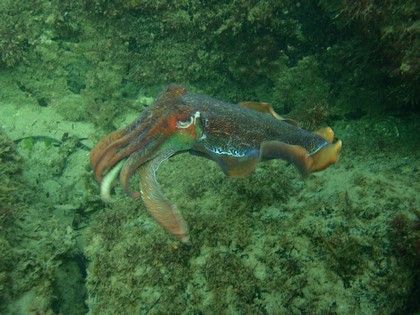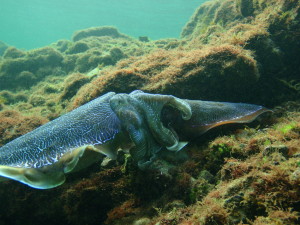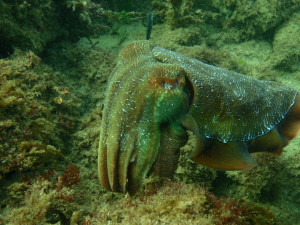When giant Australian cuttlefish, Sepia apama, mate, they meet head-to-head and embrace. The male uses a specialised arm to squirt his sperm in to the mouth of the female.
There is some short video footage by Roger Hanlon from the Marine Biological Laboratory in Woods Hole, Massachusetts available.
According to that same web page, “To initiate sex, a male spreads his arms around his partner’s head . . .. Once the deed is done, the female stores the deposited sperm in one of two places, either around the lining of her mouth or in a receptacle below her beak. Her eggs are fertilised internally before she lays them in crevices: they need to be protected since she will die at the end of the breeding season.”
Giant Australian Cuttlefish embracing head to head
(Taken by Steve Reynolds)
The web page goes on to explain that “Alexandra Schnell from Macquarie University, Australia, and colleagues observed the behaviour to learn more about mating tactics of giant Australian cuttlefish, which have a relatively short breeding season that runs from May to August. To maximise the chance of reproducing successfully, the animals mate with multiple partners.”
It was the next bit that caught my eye. The web page went on to say, “But that doesn’t mean they have sex all the time. The researchers found that males and females both had standards, although they were different for each gender.
“Females didn’t seek out a mate if they had recently had sex, displaying a white stripe across the body to let males know they were unavailable (although the males quite often failed to get the message). If the females hadn’t got lucky in a while, they were more likely to lower their standards and put on a receptive posture for any male passing by.
“Males seemed to have different criteria, showing a strong preference for unfamiliar females – the first time that discrimination of this kind has been seen in a cephalopod species. They were also more likely to hover hopefully next to females that hadn’t recently mated, suggesting that they knew successful mating was more likely in these situations. The mechanism they use to assess a mate is still unknown, although chemical cues, used by similar species, are a possibility.
Giant Australian Cuttlefish
(Taken by Steve Reynolds)
“The gender-specific deal-breakers seem to indicate that different factors influence reproductive success in male and female cuttlefish. The team plans to uncover what these driving factors are, and how prevalent they are in each gender.”
(Journal reference: Behavioural Ecology and Sociobiology, DOI: 10.1007/s00265-014-1841-5)



